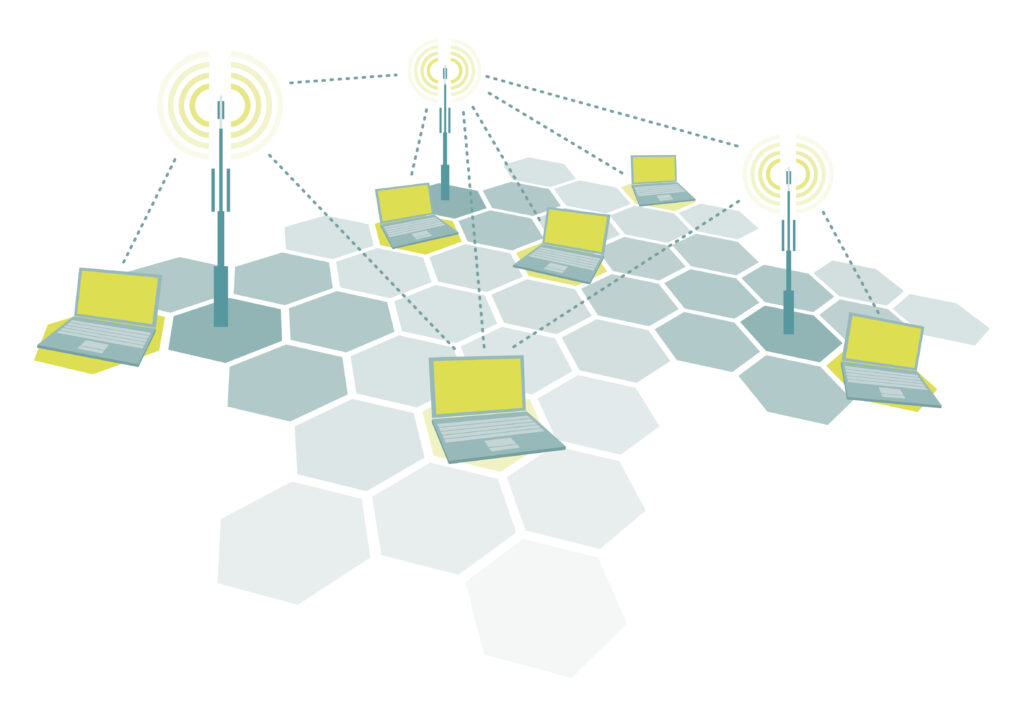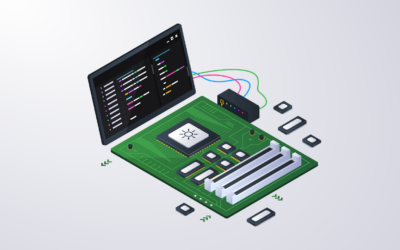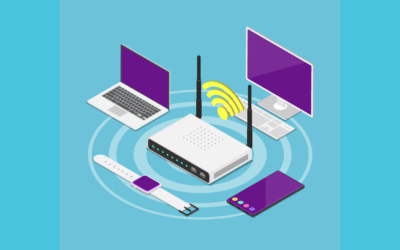Table of Content
- Overview of Mesh Networks
- What Is a Mesh Network?
- Low-Power Mesh Networks
- When to Use a Mesh Network? (Use Cases)
- Key Characteristics of Mesh Networks
- Types of Mesh Networks
- Mesh Network Architecture Design
- What Are the Disadvantages of a Mesh Network?
- Wi-Fi Mesh Networks
- Bluetooth Mesh Networks
- Comparison of Wi-Fi and Bluetooth Mesh Networks
- Other Mesh Network Technologies
- Build a Bridge for Mesh Networks
- Mesh Networks: Unlocking Business Potential
- Mesh Network Development Services
- Krasamo’s Core IoT Development Services
Overview of Mesh Networks
What Is a Mesh Network?
In a mesh network, data packets are transmitted between nodes (devices) by hopping through multiple paths (devices) until they reach their destination. These node-based communications are connected in a non-hierarchical manner and have self-organizing and self-healing features to autonomously adapt their topology to changes in conditions and availability of devices (adjust to changes in network topology). Mesh networks can be implemented using wired or wireless connections.
Mesh networks are advantageous for IoT applications compared to traditional architectures as they offer scalability, robustness, decentralized control, fault tolerance, and energy efficiency benefits. However, mesh networks also present challenges, such as increased network complexity, potential security issues, and maintenance and management complexities.
Unlike traditional mesh networks, wireless mesh networks use wireless technologies (Wi-Fi, Bluetooth, or Zigbee) to transmit data between nodes without wired connections. This makes them a more versatile and adaptable solution for various environments.
Devices in a mesh network communicate using predefined protocols. Mesh networks include Wi-Fi and Bluetooth varieties. Based on IEEE 802.11s, Wi-Fi mesh networks are used in smart homes, industrial automation, and public Wi-Fi. Bluetooth mesh networks, adhering to the Bluetooth SIG Mesh Profile, are popular in smart lighting, asset tracking, and remote-control applications.
Low-Power Mesh Networks
A low-power mesh network is a type of mesh network designed specifically for energy efficiency. With a decentralized architecture and direct device communication, low-power mesh networks use low-energy protocols and devices, making them ideal for battery-operated or power-constrained applications, such as IoT sensor networks.
As stakeholders and product owners delve deeper into the world of low-power mesh networks, it is crucial to understand the differences between these technologies and use cases.
When to Use a Mesh Network? (Use Cases)
- Smart Home and IoT Applications: Enables reliable, low-latency communication and seamless connectivity between multiple devices for easy management and control.
- Large Public Spaces and Events: Provides robust and scalable connectivity in high-density situations, overcoming limitations of traditional network infrastructure.
- Industrial Automation and Remote Monitoring: Facilitates low-latency communication and adaptability in settings where wired connections may not be feasible or reliable.
- Disaster Recovery and Emergency Response: Serves as a resilient and decentralized alternative when traditional communication infrastructure is compromised.
- Rural and Underserved Areas: Bridges the connectivity gap by delivering internet access and enabling essential services like telemedicine, online education, and e-commerce.
Key Characteristics of Mesh Networks
- Decentralized Architecture: Mesh networks do not rely on a hub or central control point with communication directly between devices (creating a distributed system), making them more resilient against single points of failure.
- Self-healing Capabilities: Mesh networks can adapt to topology changes or device availability, rerouting data through other nodes if necessary, ensuring communication and avoiding downtime.
- Scalability: Low-power mesh networks can easily adjust the addition or removal of nodes, expanding capacity without requiring reconfiguration, making them ideal for flexible and scalable infrastructure.
- Dynamic Routing: Data packets in mesh networks travel through multiple paths to reach their destination, with networks selecting the best path based on congestion, availability, and signal strength, which enables efficient load balancing and improved performance.
- Robustness and Fault Tolerance: Mesh networks’ decentralized architecture and self-healing capabilities offer robustness and tolerate node failures without causing major disruption, making them ideal for high-reliability applications.
- Energy Efficiency: Low-power mesh networks are designed to minimize energy consumption, making them ideal for applications with power constraints that use power-saving techniques to prolong battery life and reduce consumption.
Types of Mesh Networks
Full Mesh
A full mesh network connects each node directly to every other node, offering maximum redundancy and fault tolerance, ensuring that if a node fails or becomes disconnected, the network remains functional without interruption. However, this topology is complex and requires numerous connections, making maintenance and management more challenging as the network grows.
Partial Mesh
In a partial mesh network, nodes have selective connections, balancing redundancy, scalability, and manageability. This makes it a favored choice for various applications. While performance or latency might be marginally lower compared to full mesh networks, partial mesh networks offer easier management and maintenance due to fewer connections.
Hybrid Mesh
A hybrid mesh network integrates aspects of full and partial mesh topologies, customizing connections for specific use cases and balancing their benefits. By optimizing redundancy, performance, and scalability according to different network areas’ needs, hybrid mesh networks offer a versatile and adaptable solution for diverse applications.
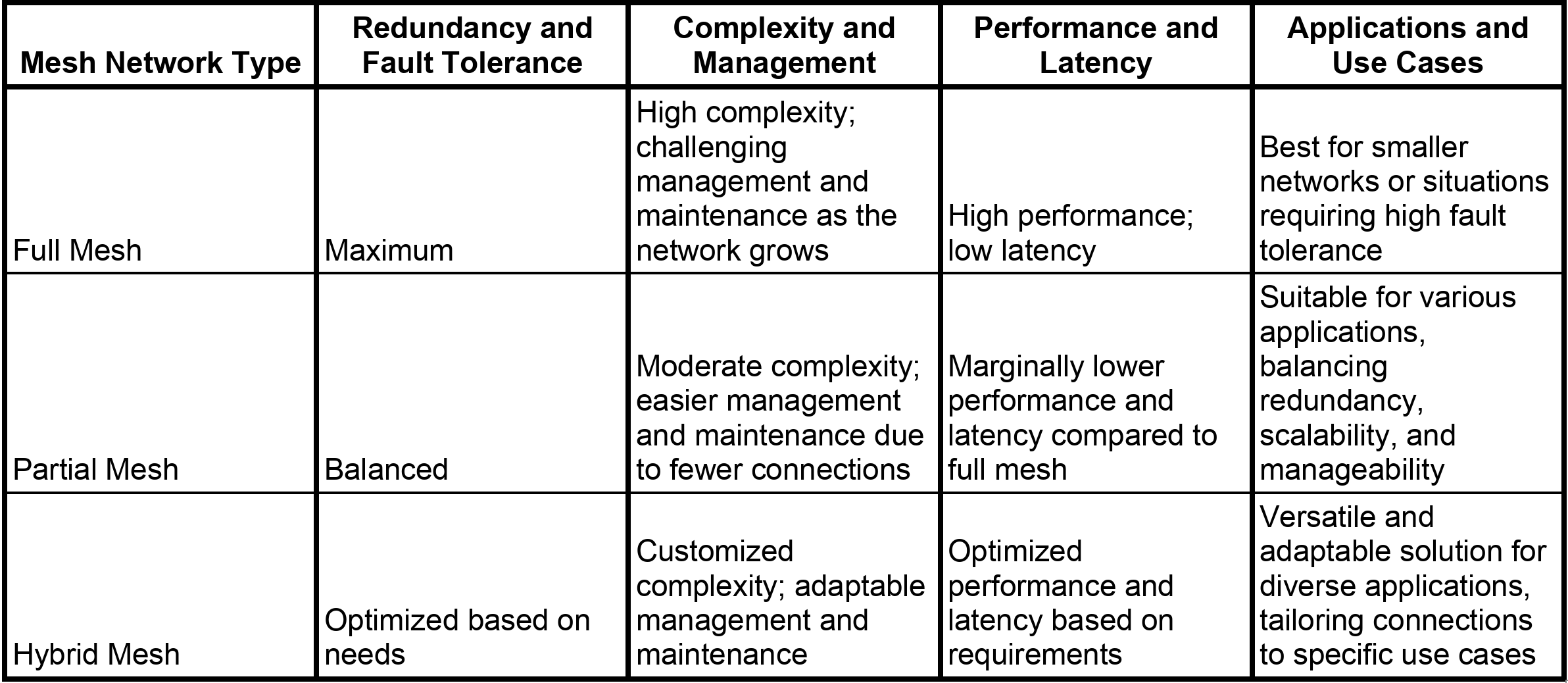
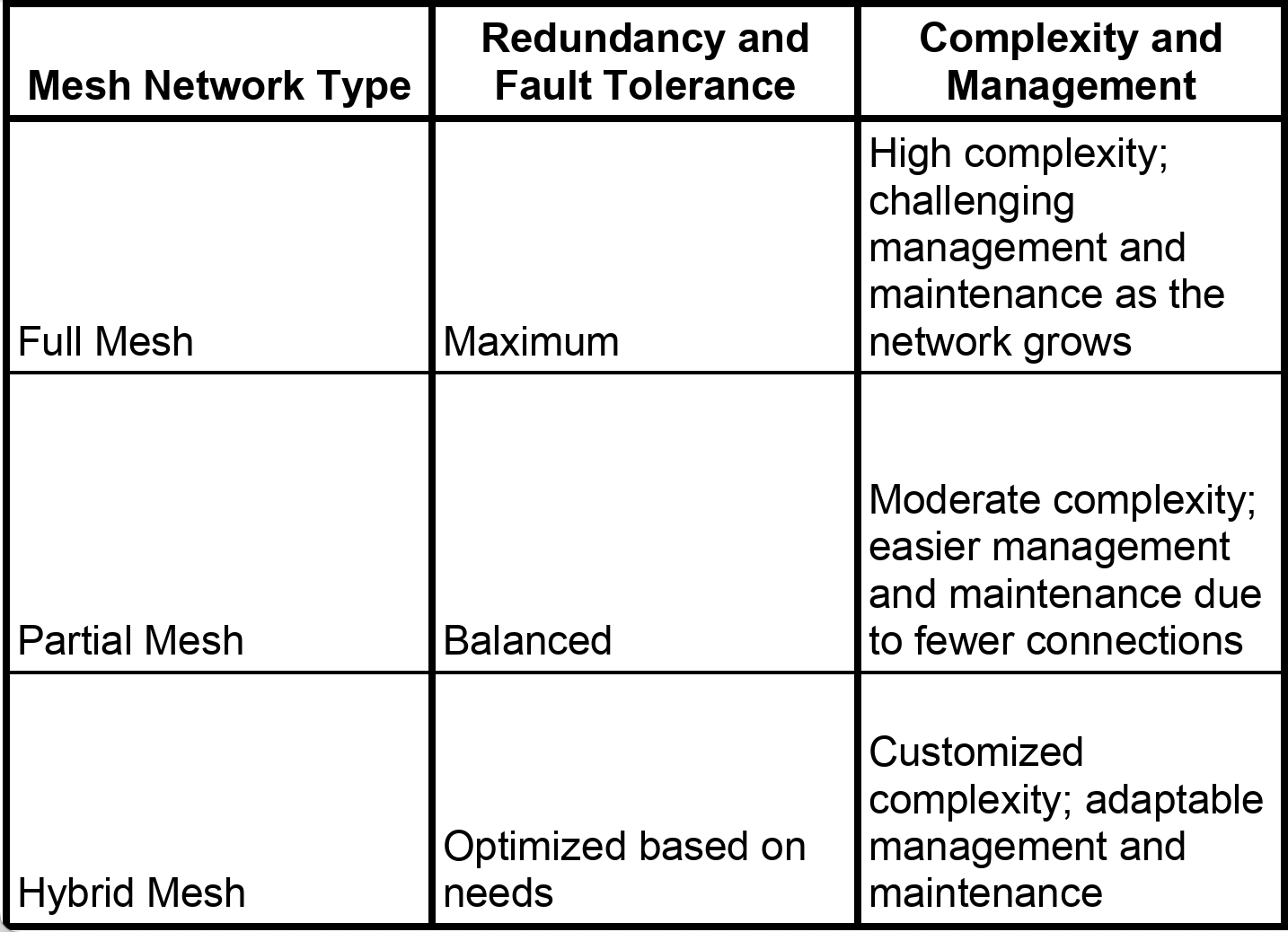
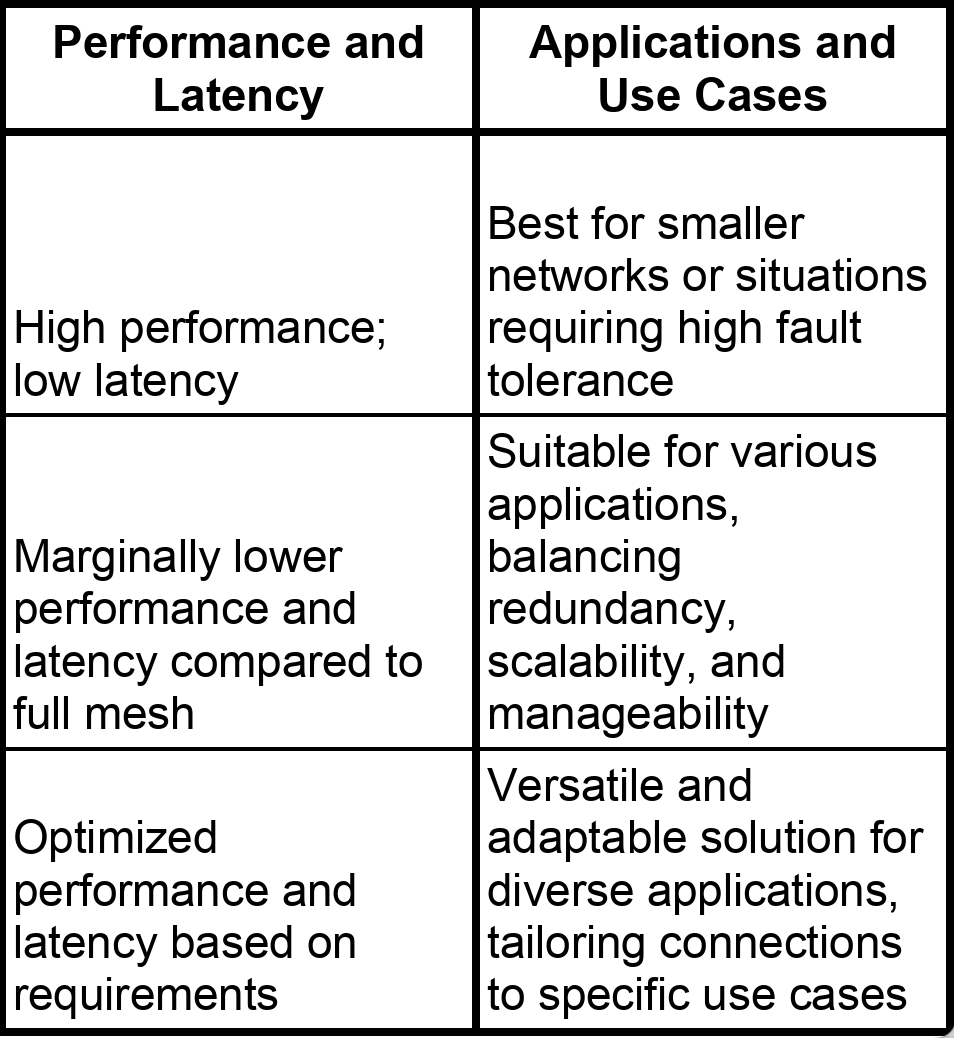
Mesh Network Architecture Design
Topology Selection (Optimal Mesh Networks Topology)
Selecting the optimal mesh network topology is crucial for catering to specific needs and constraints. Each topology presents distinct advantages and trade-offs, making it essential to choose the most suitable one for your application. Krasamo assists in determining the ideal topology that aligns with your unique requirements and limitations, considering network size, desired performance levels, and manageability. By evaluating these aspects, we can help you create a robust and efficient mesh network tailored to your specific use case and ensure seamless communication throughout the network.
Node Placement
Mesh designers consider placing nodes strategically throughout the network area, which can significantly impact the network’s performance, reliability, and coverage. Therefore, we take into account factors such as signal strength, interference, and physical obstacles when determining node locations.
Routing Protocols
We consider the routing protocol selection as crucial for efficient data transmission in mesh networks. Several routing protocols, such as Ad-hoc On-Demand Distance Vector (AODV), Dynamic Source Routing (DSR), and Optimized Link State Routing (OLSR), have been developed specifically for mesh networks. When selecting a routing protocol, consider network size, mobility, and traffic patterns. Discuss with our developers the different routing protocols that can be used in mesh networks.
Power Management
We optimize energy consumption by implementing power-saving techniques, such as duty cycling or adaptive transmission power. Design your mesh network to minimize energy usage while maintaining acceptable performance.
Security
Mesh networks may be vulnerable to security risks, including unauthorized access, eavesdropping, or man-in-the-middle attacks. Integrate encryption, authentication, and access control measures into your network design to safeguard data privacy and deter unauthorized access.
Scalability and Manageability
Design your mesh network to adapt to growth and evolving needs over time. Ensure the network can effortlessly accommodate extra nodes and incorporate monitoring and management tools to simplify network administration. A mobile app development team at Krasamo can build a mobile app to manage your mesh network, configure devices (adding or removing nodes), and create a bridge to build connectivity in the cloud.
Performance and Quality of Service
A mesh network must be designed considering the network’s anticipated traffic load, latency requirements, and reliability needs and employing mechanisms to prioritize or delay data and ensure satisfactory performance levels.
Testing and Validation
Verify your mesh network design by conducting simulations or pilot implementations before deploying it on a large scale. This approach lets you identify issues and fine-tune the design before committing resources.
By carefully considering these key aspects and potential pain points during the mesh network design process, you can create a robust, efficient, and secure communication system that meets your use case requirements.
What Are the Disadvantages of a Mesh Network?
- Network Complexity. Mesh networks involve numerous node connections, making them more complex than centralized networks and amplifying complexity in setup, configuration, and management. Due to their dynamic nature, they also require more complex algorithms.
- Increased Latency. In mesh networks, data packets may pass through multiple nodes, causing increased latency compared to centralized networks’ direct paths. This can affect time-sensitive applications or services requiring real-time communication, particularly in larger or partial mesh networks with indirect connections.
- Security Concerns. Mesh networks, especially those using wireless communication, can be susceptible to interference from other devices, physical barriers, or environmental factors. Interference can lead to reduced signal strength, decreased network performance, and unreliable connections. Addressing these issues may require additional network planning, optimization, or investment in higher-quality hardware.
- Potential Interference Issues. Wireless mesh networks may face interference from devices, physical obstacles, or environmental factors, resulting in weaker signals, reduced performance, and unreliable connections. Tackling these issues may necessitate further network planning, optimization, or improved hardware investments.
- Maintenance and Management Challenges. Mesh networks’ decentralized nature presents greater maintenance and management challenges compared to centralized networks. Troubleshooting can be time-consuming, as it involves inspecting multiple nodes and connections. Additionally, updating or patching individual nodes increases the maintenance overhead, particularly in large or evolving networks.
Wi-Fi Mesh Networks
Nodes, encompassing routers, access points, or Wi-Fi extenders, interact with other devices to propagate Wi-Fi signals, facilitating the transmission, reception, and forwarding of data packets for high-speed internet connectivity. Wi-Fi mesh networks comply with the IEEE 802.11s standard, an extension of the IEEE 802.11 Wi-Fi protocols.
Bluetooth Mesh Networks
We invite you to explore our dedicated paper on this topic for a more comprehensive understanding of Bluetooth Mesh Networks, their architecture, managed flooding approach, security, scalability, and potential applications. The paper delves deeper into the intricacies of Bluetooth Mesh Networks, addressing their key aspects and detailing how they can significantly impact the IoT landscape.
Comparison of Wi-Fi and Bluetooth Mesh Networks
Communication Protocols: Wi-Fi mesh networks utilize the IEEE 802.11s standard, whereas Bluetooth mesh networks adhere to the Bluetooth SIG Mesh Profile. These differing standards result in variations in device communication, network configuration, and data transmission processes.
Range and Bandwidth: Wi-Fi mesh networks typically provide a broader range and higher data transmission rates than Bluetooth mesh networks. Consequently, Wi-Fi is more fitting for high-bandwidth applications, whereas Bluetooth is better suited for low-power, low-bandwidth situations like smart lighting or sensor networks.
Energy Consumption: Bluetooth mesh networks usually exhibit greater energy efficiency compared to Wi-Fi mesh networks, rendering them more suitable for battery-operated devices and low-power IoT applications.
Device Types: Wi-Fi mesh network nodes typically consist of routers, access points, or Wi-Fi extenders engineered to deliver reliable, high-speed internet connectivity. In contrast, Bluetooth mesh network nodes encompass a broader range of devices, including sensors, actuators, or controllers, tailored for specific IoT applications such as smart lighting or asset tracking.
Network Size: Wi-Fi mesh networks can accommodate a greater number of nodes than Bluetooth mesh networks. As a result, Wi-Fi mesh networks are more appropriate for applications with high device density or extensive coverage areas.
Other Mesh Network Technologies
- Zigbee Mesh Networks: Zigbee is a widely used low-power mesh networking protocol designed for IoT devices, smart homes, and industrial automation. Many manufacturers support it and offer low-latency communication.
- Z-Wave Mesh Networks: Z-Wave is a specialized wireless protocol for home automation, leveraging low-energy radio waves. It primarily connects various smart devices and home appliances. Its core strength lies in offering broad compatibility with numerous products, allowing direct and indirect interactions. Additionally, it operates on a frequency distinct from Wi-Fi and Bluetooth, thereby minimizing interference.
- Thread Mesh Networks: Developed by the Thread Group, Thread is an IPv6-based, low-power mesh networking protocol tailored for IoT and smart home applications. Supported by major industry players, it offers secure, reliable, and scalable communication. Despite being relatively new, it is backed by industry giants and is expected to boost its adoption in the near future.
- 6LoWPAN (IPv6 over Low-Power Wireless Personal Area Networks) is a networking protocol that facilitates the efficient transmission of IPv6 packets over low-power and low-bandwidth wireless networks. This protocol is particularly useful for IoT devices with limited processing capabilities, memory, and energy resources.
- AI and ML in Mesh Networks: Integrating AI and ML algorithms into mesh networks can boost routing, load balancing, fault detection, or energy consumption, resulting in increased network performance, efficiency, and optimized resource usage for seamless communication. These technologies aid in gathering data and extracting features (feature engineering) about node positions, communication patterns, network topology, and performance metrics (e.g., latency, throughput, packet loss).
- Integration with 5G Technology: Mesh networking can work alongside 5G networks to improve connectivity in areas facing coverage limitations or high network demands, making it a valuable asset for urban settings or large-scale IoT deployments as 5G technology continues to expand.
Build a Bridge for Mesh Networks
A bridge in a mesh network, also often referred to as a gateway or an edge router, that plays a crucial role in enabling communication between different networks that use different protocols.
- Protocol Translation: Bridges can translate data between different network protocols, allowing devices that use different communication methods to interact. For instance, a bridge might translate messages between Zigbee devices and a Wi-Fi network.
- Connecting to External Networks: Bridges often provide the connection between the local mesh network and an external network like the internet. This allows devices on the mesh network to access or be accessed by devices or services on the external network.
- Network Expansion: Bridges can also be used to connect and coordinate multiple mesh networks, facilitating the expansion of the network over a larger physical area.
- Data Aggregation and Processing: In some instances, the bridge can serve as a point for data aggregation and processing, reducing the load on individual network nodes and optimizing network performance.
- Security: Bridges can provide a level of security by controlling access to the mesh network, filtering incoming traffic, and possibly encrypting communication.
Mesh Networks: Unlocking Business Potential
- Cost Savings: Reduced energy consumption leads to lower operational expenses.
- Scalability: Partial mesh topologies enable businesses to easily add or remove nodes with minimal configuration, capturing new product opportunities and revenue streams.
- Reliability: The decentralized nature of the network enhances resilience against failures, ensuring continuous communication vital for customer trust and fostering relationships crucial for sustainable business operations.
- Enhanced Performance: Dynamic data routing capabilities enable efficient load balancing and improved performance, resulting in increased productivity and customer satisfaction, which support the development of new and advanced applications and generate higher revenues.
- IoT Integration: IoT devices streamline business operations and facilitate the development of new business models, products, or services, creating additional revenue streams.
- Reduced Infrastructure: A decentralized network architecture reduces infrastructure and maintenance costs, leading to further savings.
Mesh Network Development Services
As IoT consultants, we can help assess your requirements, choose the right technology, and deploy the network to meet your specific needs. The following Mesh Networks Development Services can be outsourced to Krasamo as an IoT development/integrators partner:
- Design and development of mesh network architecture
- Deployment and commissioning of mesh networks
- Support and maintenance of mesh networks
- Security and compliance of mesh networks
- Testing and validation of mesh networks
- Consulting and advisory services for mesh networks
- Development of mobile applications and bridges for mesh networks

